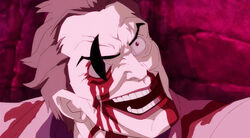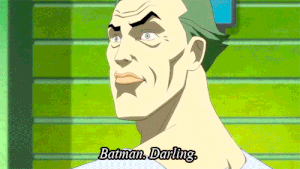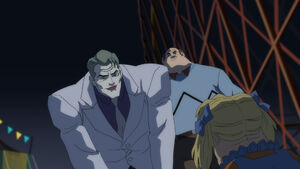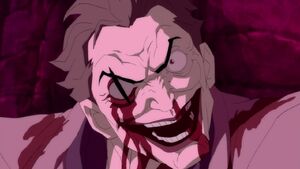| | ||
|
This Villain was proposed and approved by Villains Wiki's Pure Evil Proposals Thread. Any act of removing this villain from the category without a Removal Proposal shall be considered vandalism (or a futile "heroic" attempt of redemption) and the user will have high chances of being | ||
| “ | It's finally here, isn't it? The moment we've both dreamed about! Oh, don't tell me you're gonna fall asleep before we finish. You have gotten old haven't you? | „ |
| ~ Joker to Batman describing their final fight as something epic. |
The Joker is one of the main antagonists of Frank Miller's 1986 Batman: The Dark Knight Returns comic book miniseries, a posthumous antagonist on its 2002 sequel miniseries The Dark Knight Strikes Again, an unseen antagonist on the 1988 story arc Batman: Year One and the main antagonist on the 2008 prequel series All-Star Batman & Robin, the Boy Wonder.
Like in most incarnations, the Joker is a psychopathic mass murderer who is Batman's archenemy. Following Batman's retire, he gets confined to Arkham Asylum and is left in a catatonic state, but when Batman returns ten years later, he comes back as well for a final showdown with the Dark Knight.
He is also a major antagonist in the 2012-2013 animated film adaptation of The Dark Knight Returns. Essentially, The Joker serves as a minor character in Part 1 and later becomes the main antagonist in the first half of Part 2.
He was voiced by Michael Emerson, who also played Benjamin Linus in Lost, Zep Hindle in Saw, and Cayden James in Arrow.
Biography
Batman: Year One
While the Joker doesn't appear in the story, he gets mentioned at the end of it. After Batman succeeds in forcing Gillian B. Loeb to resign as Commissioner and James Gordon is promoted to Captain, Gordon reunites with him on a rooftop and informs him about somebody known as the Joker, who is plotting to poison the reservoir.
The Dark Knight Returns
| “ | B-B...B-B-Batman...Darling. | „ |
| ~ The Joker reawakening. |
Well into his 60s, the Joker spends 10 years at Arkham Asylum in a near catatonic stupor. When news hit the wire that Batman, his arch-nemesis, has come out of retirement, the Joker's conscious mind resurfaces and he decides that it's time for him to come out of retirement as well. As such, when he receives a visit from his former henchman Abner, who has been asked by the "reformed" Harvey Dent to fabricate some bombs for him, the Joker instructs him into rigging the bombs to sabotage Dent's plant, but Batman foils the attempt. The Joker also asks Bruno, his Neo-Nazi henchwoman and "girlfriend", to rob random stores in Gotham City, possibly to raise funds for his operations.
After the Joker manipulates Doctor Bartholomew Wolper, his naive and glory-hound psychiatrist, into declaring him 'cured', the doctor proclaims the Joker as merely a victim of Batman's own psychosis, which is quite stupid as he killed tons of people in the past without Batman's influence. The Joker is invited to the Late Night with David Endochrine talk show, where his psychiatrist had intended to publicly reveal his 'recovery'. However, the Joker instead uses Bobby to murder all the audience, including Wolper and Endochrine. Afterwards, Joker then breaks into Selina Kyle's escort service and, after he brainwashes her with a kiss via his mind-control lipstick, proceeds to order her to bring one of her escorts, Elsie, and then brainwashes her offscreen (presumably via the same method as with Selina) to manipulate the Senator Hector Alejandro Noches into declaring nuclear war between the US and the USSR (presumably also having her wear the same mind-control lipstick to ensure that she got the senator to agree).
Later on, the Joker dresses Selina up as Wonder Woman, bounds, beats and gags her as well as presumably rapes her before he takes hostages at a local carnival along with Abner but not before poisoning boy scouts with venomous cotton candy. After he tracks down the Joker there, while Robin goes after Abner, Batman engages his foe in the hall of mirrors, where an extremely violent and brutal showdown-turned-fist fight erupts between the two. The Joker drops a mirror on Batman and makes his escape into the tunnel of love ride. Batman reappears and engages the Joker a second time in a far more violent fight, in which the Joker hysterically stabs him in the stomach several times. Mid-stab, Batman instinctively breaks the Joker's neck just enough to paralyze him.

Joker laughing his last laugh while he snaps his own neck.
As a group of innocents, who believe that Batman murdered the Joker, scream and flee, Batman confronts his opponent. Although the Joker eagerly provokes Batman into finishing him off, Batman is unable to, much to his disappointment. Nevertheless, the Joker sneers at him, and arrogantly claims that he won the fight - he made Batman lose control and 'kill' him, and the people of Gotham would condemn and hunt him because of it. The Joker then finally says "See you in Hell!., before, in a last act of revenge against his enemy, twists his neck just far enough to kill himself, committing suicide and framing his enemy for his own murder. After so many years of waging a seemingly eternal one-on-one war, Batman had finally won the fight against the Joker, but the Joker had won their argument.
As SWAT officers led by Commissioner Ellen Yindel make their way into the tunnel of love to arrest Batman, Batman gives one final glare to his deceased archenemy and spits on him. The Joker's corpse later catches fire when one of Yindel's officers touches it, and remains burning as Batman makes his way off the ride to escape with Robin.
Personality
After hearing wind of Batman's return, Joker was shocked out of his catatonic state and quickly reverted back to his sociopathic, manipulative, villainous, and sadistic personality. His genius personality resurfaced as well, being able to pretend he felt remorse for his actions and that he was a victim of Batman's own psychotic obsession, to this Joker replies "I thought I was Batman's psychotic obsession." Another thing that returned was a love for theatrics, murdering his psychiatrist and the entire audience in front of Gotham city during a televised talk show. It's interesting however how Joker killed his psychiatrist only after he spoke ill of Batman, it's probably because he felt only he could talk that way about his archenemy.
Joker went to incredible lengths to cause Batman pain and ruin his reputation this was including the lives of others and his own. To cause him pain he kidnapped, beat and presumably raped Selina Kyle. Near his final moments he displayed his usual lack of remorse, showing no mercy to any of his victims claiming "I never kept count" (of the people he killed) instead was arrogant and mocking, claiming he had won, as two civilians thought they saw Batman snap his neck when he just paralyzed him. He later committed suicide as to destroy Batman's reputation, finally defeating his archenemy in death, although he was slightly disappointed that Batman didn't murder him outright when telling him to finish him.
Gallery
Images
Videos
Trivia
- Contrary to what many people believe, this version of the Joker was actually the first one revealed to have killed Jason Todd before the mainstream version in the acclaimed Batman: A Death in the Family story arc, which was published two years after The Dark Knight Returns. The most notable differences between the two versions is that Todd's death in the first one is just considered canonical to Frank Miller's Dark Knight Universe and that Jason never resurrects as Red Hood in such continuity.
- Despite the two different realities, however, the 2016 one-shot Dark Knight Returns: The Last Crusade reveals that Jason's death in Miller's continuity was nearly the same as in the mainstream continuity: beaten to death by the Joker's henchmen under his orders, yet the Joker didn't use any bomb nor he seemingly participated in the beating.
- There's a rumor which says that Frank Miller originally intended to state in The Dark Knight Returns that the Joker actually raped Jason Todd before killing him but that DC Comics stepped in and forced Miller to take it out. However, this Joker has been hinted anyway in further works to be a rapist.
- Ironically, the infamous series finale for the TV series Lost (which was one of Michael Emerson's prior roles), was earlier referenced by The Joker in Batman: Arkham City where Joker asked why it all ended in a church. Interestingly, in the prequel Batman: Arkham Origins, when dressed as Black Mask upon getting unsmasked by Batman, the Joker's white tuxedo seems to be a reference to his Frank Miller portrayal.
- In a behind the scenes feature for the film, Michael Emerson stated that he modeled the Joker's voice on comedian Paul Lynde.
- In the original comic, the Joker has Bartholomew Wolper killed by having his neck snapped by Bobby, but in the film, he breaks David Endochrine's coffee cup to slit Wolper's throat. The latter was most likely done to reference the version from Batman: Under the Red Hood, where the Joker breaks a water glass to slit the throat of one of Black Mask's henchmen to then kill all his remaining men except Black Mask himself and Ms. Li.
Template:Approved Evil Articles Navigation








